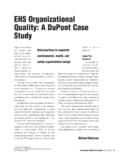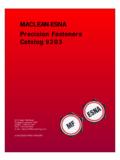Transcription of EHS, By the Numbers - Ricahrd MacLean & …
1 8 THE GREEN BUSINESS LETTER/OCTOBER 2001 2001 TILDEN PRESS INC. REPRODUCTION STRICTLY PROHIBITED WITHOUT E-FACTOREHS, By the NumbersWhat s the ideal EHSstaffing ratio?There is no such THIS YEAR, I RECEIVED Acall from a finance departmentmanager who was given the task of taking the fat out of a multi-billion-dollar firm. She wanted toknow the ideal environmental staffratio based on her company s sizeand sector. When I started to gointo a list of factors that needed tobe considered, she got annoyed. Itreminded me of the times I askedengineers what I thought weresimple questions, only to havethem drone on with details.
2 Justgive me the number !Asking someone for the timeand getting a lecture on building awatch would annoy anyone. Tothis woman, her staffing issue mustbe just as staffing ratios work fortask-oriented service functionssuch as payroll, not in the EHSworld. I refused to give her anumber, suggesting that a simpleevaluation be performed to firstevaluate the key would have none of she may repre-sent the norm, rather than theexception. I am familiar withscores of staffing decisions madein a matter of seconds by ill-informed executives who consid-ered environmental, heath, andsafety functions as strictly chores:fill out the forms, train the staff,control the emissions, etc.
3 If itwere only this simple, usingbenchmark ratios would be theway to DECADES, COMPANIES HAVE benchmarked their staffing levelsagainst industry norms. Ratiossuch as employees per productionvolume represent the most basicmeasures of productivity andprofits. There are specific EHSactivities where standard industryratios may be a valid methodologyto size staff support. For example,regulatory-required personneltraining and industrial hygienemonitoring are well-defined tasksthat can be normalized against astandard unit, namely a rule, the more the serviceresembles a well-defined com-modity, the more likely thatsimple ratios or other factors canbe reliably presents an interestingparadox: Commodity services aretypically the first to be anything, staff comparisonsusing ratios are even less reliabletoday than in the staffing surveys do notclearly differentiate between full-time professionals and collateralsupport.
4 The prominence ofoutsourcing today also requires ananalysis of total resources, not justinternal staff. In addition, keynetworking and other interfacerelationships that may profoundlyaffect how these resources worktogether are rarely surprisingly, survey resultsare all over the map. For example,a benchmarking study of largecorporations, conducted byCompaq Computers, reported avariation in EHS staff size from 3to 200 per billion dollars ofrevenue. Another survey con-ducted by a major consulting firmcontains charts that look likerandom scatter diagrams. Yetanother survey found a 13-to-1spread in staffing levels in theutility SURVEYS HAVE THEIR place.
5 Your company s manage-ment team may require you touse them as part of an EHSresource review, which may beone element in a broader study byoutside management consultantsto restructure the entire organiza-tion. (Beware of consultants: Ihave seen EHS departments rightsized by consultants whowere clueless on how to properlyrun an EHS function, but weregiven this responsibility becausethey were evaluating overallstaffing levels.) You might usebenchmarking data to justify yourdepartment s staffing duringrightsizing, though it should notbe the primary argument, andcertainly not the sole justificationto maintain the status sad fact remains that thereis extremely limited informationpublished on sizing or organizingEHS staff resources.
6 And in theabsence of irrefutable informa-tion, herd mentality trumps rush to place EHS intoshared service or outsource thesefunctions are classic examples of amanagement idea carried tounfortunate extremes. Those whoexperienced such ordeals are onlynow starting to repair the , there are techniques tosize an EHS organization, butbenchmarking and simple ratiosare not the way to go about it. Richard MacLeanMacLean is president of CompetitiveEnvironment Inc.( ), amanagement consulting firm inScottsdale, Ariz., and director of theCenter for Environmental Innova-tion ( ).
7 Adapted from a forthcoming articlein Environmental Protectionmagazine ( ).





